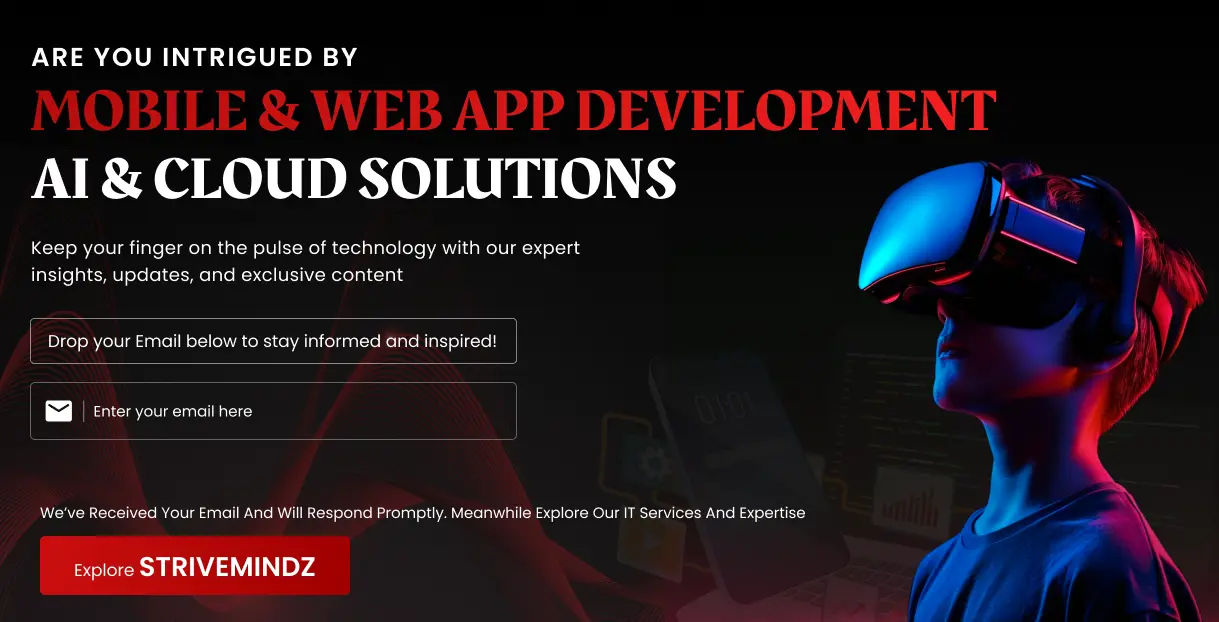The Future of iOS App Development: Trends and Predictions in 2024

Unleash your app idea today! Dive into the world of iOS app development and turn your vision into reality.
A mobile-first, customer-centric approach will help companies thrive in the fast-paced mobile app industry in 2024. With over 6.9 billion smartphone users worldwide, it’s no surprise that mobile apps will play a key role in many industries.
The mobile app is now the backbone of every transaction, and we can expect innovative solutions to emerge from them shortly.
This year, we’ll explore iOS app development trends that will shape how companies build products and services in 2024 as we continue to focus on generative AI.
Introduction to iOS App Development
The magic of transforming your ideas into an app that millions can use – that’s the allure of iOS development. Whether you’re a seasoned programmer or a tech enthusiast with a spark of creativity, this field offers exciting opportunities to shape the way people interact with their iPhones, iPads, and other Apple devices. But where do you begin? This comprehensive guide aims to be your launchpad into the world of iOS development, providing a roadmap to navigate the essential tools, concepts, and resources.
Here are some basic iOS app development tips for beginners.
Unveiling the Tools of the Trade
Your journey starts with Xcode, the integrated development environment (IDE) built by Apple. This is your command center, where you’ll write code, design interfaces, test your app, and prepare it for release. Inside Xcode, you’ll befriend Swift, the official programming language for iOS development. Known for its clarity and safety features, Swift empowers you to bring your app ideas to life with efficient and readable code.
Building the Blocks of an App
Every app is built on fundamental elements. UIKit, the cornerstone framework, provides the building blocks for your app’s visual interface, from buttons and text fields to animations and transitions. Understanding how to manipulate these elements with Swift code forms the core of your app’s functionality.
Beyond the interface, your app needs structure. Learn about design patterns like Model-View-Controller (MVC) and Model-View-ViewModel (MVVM) that organize your app’s code into clean and maintainable sections. This ensures your app grows steadily and remains manageable even as it gains complexity.
Connecting to the World
Apps rarely exist in isolation. They often need to interact with data and services, like accessing user location, displaying maps, or integrating with social media platforms. This is where APIs (Application Programming Interfaces) come in. Think of them as messengers, allowing your app to communicate and exchange information with external sources. Learning how to use APIs effectively unlocks a vast potential for your app’s functionalities.
Your Learning Arsenal
Ready to put your learning into action? Dive into the treasure trove of resources available:
- Apple Developer Documentation: Your official guide to all things iOS development, packed with detailed tutorials, code samples, and API references. Consider it your first stop for any question or clarification.
- Online Courses and Bootcamps: Structured learning paths cater to all levels, from beginner-friendly introductions to advanced specialization courses. Platforms like Coursera, Udacity, and Udemy offer a diverse range of options to suit your learning style and pace.
- Developer Communities: Don’t underestimate the power of community! Tap into the collective knowledge and support of online forums, social groups like the Apple Developer Forums, and local meetups. Connect with other iOS developers, share experiences, and learn from each other’s journeys.
Taking the First Steps
Now, let’s translate theory into practice:
- Set up your development environment: Download and install Xcode on your Mac. Familiarize yourself with the interface and tools.
- Learn the basics of Swift: Start with beginner-friendly Swift courses or tutorials to grasp the programming fundamentals. Online platforms like Apple’s Swift Playgrounds offer interactive ways to experiment and learn.
- Build your first app: Apple provides excellent official tutorials that guide you through creating your first simple app. This hands-on experience will solidify your understanding of the development process.
- Practice and explore: Don’t be afraid to experiment and build small projects on your own. This is where you truly learn and refine your skills. Explore open-source projects on platforms like GitHub, where you can contribute and learn from experienced developers.
Remember, the journey of a thousand lines of code begins with a single step. Start small, be persistent, and don’t hesitate to seek help when needed. The iOS development community is welcoming and supportive, and there are countless resources available to guide you on your path. With dedication and curiosity, you can unlock the potential to create innovative apps that enrich the lives of millions.
This introduction provides a foundation, but the world of iOS app development is vast and ever-evolving. As you progress, delve deeper into specific areas that pique your interest, whether it’s user interface design, game development, or integrating cutting-edge technologies like AR/VR. Embrace the continuous learning mindset, and remember, the possibilities are truly endless in the dynamic world of iOS app development!
Mobile Application Development Market Size, Share & Growth Report by 2030
Several market research firms publish reports on the Mobile Application Market Size, Share & Growth. While providing a definitive answer is impossible due to different methodologies and data sources, here’s a summary of key insights from leading reports for 2030:
Market Size:
- Grand View Research: Estimates the global mobile app market size to reach USD 567.19 billion by 2030, with a CAGR of 13.8% from 2023.
- Statista: Projects the market to reach USD 655 billion by 2031, with a CAGR of 13.7% from 2022.
- Allied Market Research: Forecasts the market to reach USD 1,481.82 billion by 2030, with a CAGR of 18.5% from 2022.
Market Share:
- Grand View Research: Identifies North America as the leading region in 2023, followed by Europe and Asia Pacific.
- Statista: Reports similar regional leadership, with North America having the highest share.
Driving Forces:
- Smartphone Proliferation: Increased smartphone penetration, particularly in developing regions, fuels demand for new and diverse apps.
- Technological Advancements: Emerging technologies like AI, AR/VR, and 5G create exciting opportunities for innovative app experiences.
- Evolving User Needs: Changing consumer preferences and demands for on-demand services, personalized experiences, and seamless connectivity drive app development.
- Business Transformation: Businesses embrace mobile apps to enhance customer engagement, streamline operations, and reach new markets.
Segmentation:
- The market is segmented by region (North America, Europe, Asia Pacific, etc.), platform (iOS, Android), and application type (gaming, e-commerce, healthcare, etc.).
- Each segment exhibits different growth patterns and trends based on local factors and user preferences.
Future Outlook:
- The market is expected to continue growing, driven by factors like:
- Increased 5G adoption
- Rising internet penetration
- Growing emphasis on privacy and security
- Integration of emerging technologies
Potential Challenges:
- Increasing competition and app store saturation
- Data privacy regulations and user concerns
- Talent shortage and developer skill gap
Key Players:
- Major players include Apple, Google, Microsoft, Adobe, IBM, and numerous independent developers and agencies.
Overall: The mobile app development market offers promising opportunities for businesses and developers alike. Staying informed about trends, embracing emerging technologies, and addressing user needs are crucial for success in this dynamic and growing market.
Trends and Predictions for iOS Development in 2024
The iOS development landscape is constantly evolving, driven by cutting-edge technologies and ever-changing user needs. As we delve into 2024, several exciting trends are shaping the future of this dynamic field. Let’s explore the key areas that will likely dominate the scene and equip you with valuable insights for navigating this dynamic environment.
AI and Machine Learning (ML) Take Center Stage:
- Core ML, Apple’s framework for on-device machine learning, will see significant advancements, enabling developers to seamlessly integrate intelligent features into their applications. Expect apps to become more personalized, context-aware, and proactive, leveraging user data and preferences to deliver richer experiences.
- Natural Language Processing (NLP) will play a crucial role in driving intuitive communication within apps. Features like voice-driven interfaces, sentiment analysis, and text summarization will become more sophisticated, blurring the lines between humans and machines.
Augmented Reality (AR) and Virtual Reality (VR) Gain Traction:
- ARKit and RealityKit, Apple’s AR and VR development tools, will continue to mature, offering developers greater flexibility and creative control. We’ll see AR integrated into more everyday tasks, enhancing shopping experiences, educational tools, and even navigation.
- VR, while still in its nascent stages on iOS, holds immense potential for gaming, entertainment, and immersive training simulations. As hardware advancements and accessibility improve, VR development could witness a significant upsurge in 2024.
The 5G Revolution Ushers in New Possibilities:
- The widespread adoption of 5G networks will unlock faster data speeds, lower latency, and improved reliability. This opens doors for innovative app experiences, such as real-time AR/VR applications, high-fidelity video streaming, and seamless cloud integration.
- Developers will need to optimize their apps to leverage the potential of 5G, ensuring they load quickly, function smoothly, and provide a flawless user experience even on bandwidth-intensive tasks.
Security and Privacy Remain Paramount:
- With growing user concerns about data breaches and online safety, Apple will continue to prioritize security and privacy in its iOS ecosystem. Developers will need to adhere to stricter data protection regulations and implement robust security measures to build trust and transparency with users.
- Features like App Tracking Transparency and on-device data processing will become even more prevalent, empowering users with greater control over their data and limiting unauthorized access.
Swift Evolution and the Rise of SwiftUI:
- Swift, the primary programming language for iOS development, will continue to evolve with new features and performance improvements. Developers will need to stay updated with these advancements to stay competitive and create efficient, modern apps.
- SwiftUI, Apple’s declarative user interface framework, will gain wider adoption due to its ease of use and code efficiency. Expect to see more visually stunning and intuitive app interfaces built with SwiftUI in 2024.
Predictions for iOS 17:
While Apple keeps details under wraps, here are some educated guesses for what iOS 17 might hold:
- Deeper integration of AI and ML: Expect enhancements to Core ML, improved Siri functionality, and more AI-powered features across the system.
- AR/VR enhancements: Apple might introduce new ARKit and RealityKit features, paving the way for more seamless and immersive AR/VR experiences.
- Health and wellness focus: Continued focus on health and fitness features, possibly with deeper integration with Apple Watch and health data.
- Privacy innovations: Apple might introduce new privacy-centric features to further empower users and control their data.
Staying Ahead of the Curve:
Navigating the ever-evolving iOS development landscape requires continuous learning and adaptation. By staying informed about these key trends and predictions, developers can equip themselves with the knowledge and skills to create innovative, user-centric apps that thrive in the competitive market. Remember, the future of iOS development is brimming with exciting possibilities, and those who embrace these trends will be at the forefront of shaping the way users interact with their devices.
This article provides a starting point for further exploration. Remember to delve deeper into specific areas that pique your interest and stay updated with the latest advancements as we progress through 2024 and beyond. The future of iOS development is bright, and the opportunities for creating impactful and groundbreaking apps are vast.
iOS Development Cost Comparison by Country (2024)
| Country | Average Hourly Rate (USD) | Project Cost Range (USD) | Factors Affecting Cost |
|---|---|---|---|
| United States | 80-150 | 50,000-300,000+ | High talent cost, complex regulations |
| India | 25-50 | 15,000-100,000 | Lower talent cost, larger talent pool |
| Eastern Europe | 40-60 | 25,000-150,000 | Balance of cost and talent, diverse skillsets |
| Western Europe | 60-90 | 40,000-200,000+ | High talent cost, strong technical expertise |
| South America | 35-50 | 20,000-120,000 | Lower talent cost, growing talent pool, varying experience |
Final Words
By 2024, iOS app development will be continuously adapted to emerging technologies like AR/VR, AI/ML, blockchain, and cloud computing.
Staying on top of this rapidly evolving field is crucial for any mobile app development company. As well as ensuring developers can fully utilize the iOS platform’s potential and deliver innovative apps that meet users’ needs.
Currently, there are over 6.6 million apps available for Android and iOS. Technology trends must be aligned with developers’ needs in order to build a loyal user base and foster better user experiences.
If you want to capitalize on the latest Android and iPhone app development trends outlined in this article, hire iOS app developers for best-in-class implementation. Get in touch with us today for iOS app development cost estimate!
iOS development FAQs
What are the essential tools for iOS development?
Xcode (development environment)
Swift (programming language)
Simulator and physical device for testing
What are the biggest challenges for beginners learning Swift?
Understanding object-oriented programming concepts
Memory management
Working with closures and delegates
What are some popular frameworks for iOS development in 2024?
UIKit (building the user interface)
Foundation (essential building blocks)
SwiftUI (modern declarative UI framework)
What are some important design principles for iOS apps?
User-centered design
Consistency with Apple’s design guidelines
Intuitive interactions and navigation
Accessibility for all users
What are different strategies for testing an iOS app?
Unit testing individual code components
UI testing the user interface and interactions
Beta testing with real users
How can I use machine learning in my iOS app?
Core ML framework for on-device machine learning
Cloud-based services like TensorFlow Lite
What are the biggest trends in iOS development in 2024?
AI and machine learning integration
AR/VR adoption
Focus on privacy and security
New and evolving APIs and frameworks

